Best cycling computers: Our top-rated GPS enabled computers for routing and training
The best cycling computers can enhance your ride by helping you explore new routes or by allowing you to train more effectively.
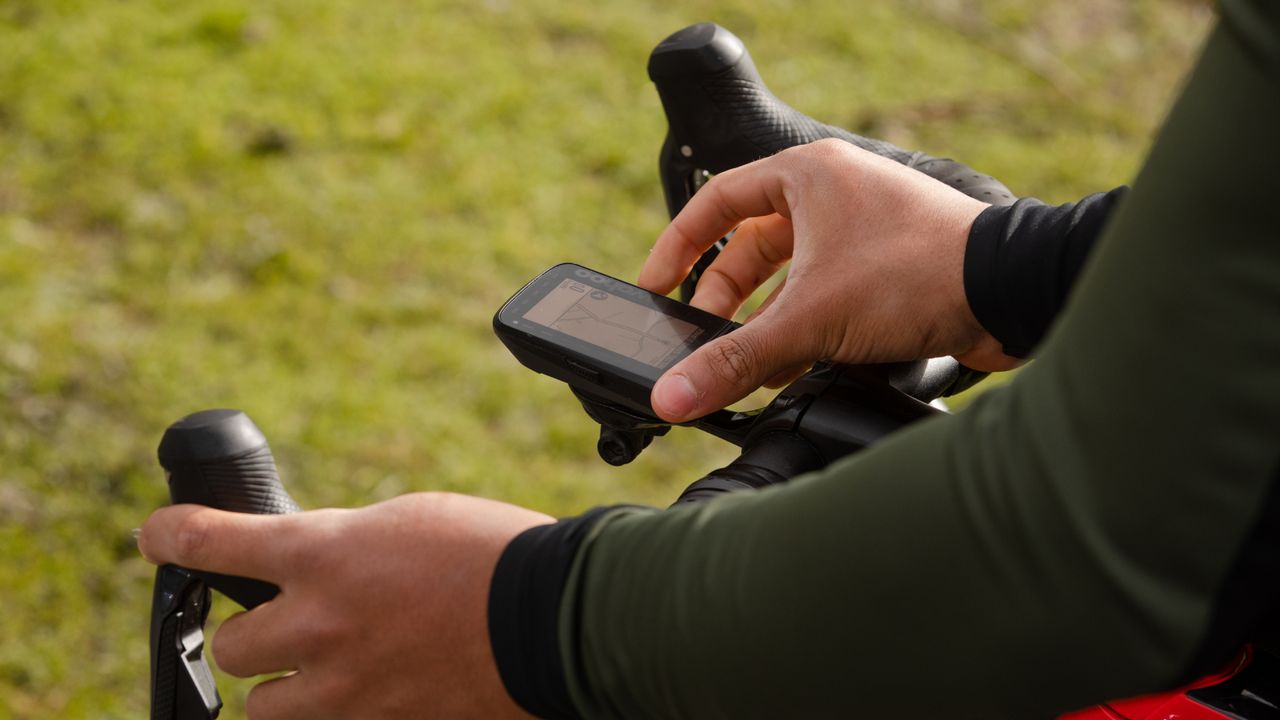

The best cycling computers track you along your ride using GPS to gather vast amounts of data to be analysed on the move or at home on one of the many cycling apps.
The latest computers are full of features and tech that most will never find a use for. Take the Garmin Edge 1050, a sim card short of being a smartphone, it will now let you pay for your mid-ride coffee and even has an electronic bell. Even more basic options like the Garmin Edge 130 plus come backed with training features and include connecting to your phone for alerts, heart rate monitors and power meters.
This guide features 12 of our highest-rated computers, of which we rate the Hammerhead Karoo 2 as the best cycling computer you can get your hands on. Its large touchscreen is flawless however, it's the Karoo's Android operating system that could make it a near future-proof option. Closely followed by the popular Wahoo Elemnt Roam with its excellent ecosystem and app support but if you are like me it's the physical buttons that sell it.
I would like to give an honourable mention to the Garmin Edge 540. The 540 has everything you need and nothing you don't, known for being a reliable and bug-free unit. It would be rude not to mention the Coros Dura, a relative newcomer, it boasts an almost unbelievable battery life.
The quick list
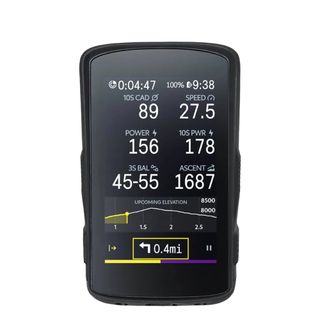
Best overall
The Karoo 2 has a large, high-resolution touchscreen that is responsive and easy to read. It uses an Android operating system and so benefits from an intuitive design and regular updates.
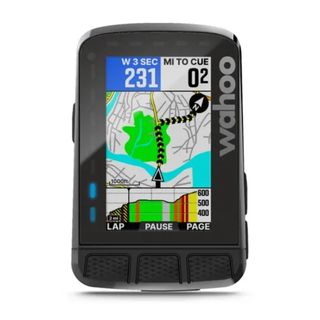
Best all-round
Buttons rather than a touchscreen operate the Roam, which will be a pro to some users and a con to others. Training and navigating functions are done well, but battery life could be better.
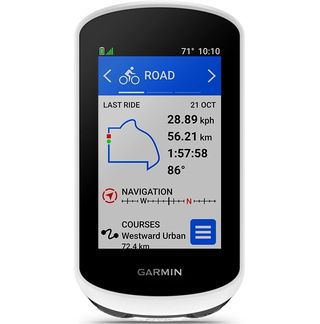
Best value for navigation
Aimed more at navigation than training, the Edge Explore 2 lacks certain functions such as Strava Live, but it can still be used with a power meter, etc. It is significantly cheaper than some options too, so well worth considering.
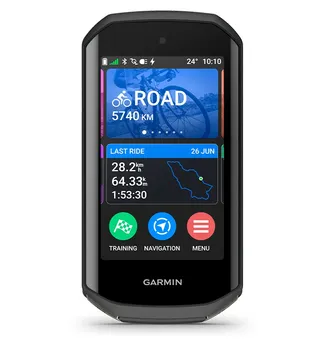 Best screen & features
Best screen & features
Best screen & features
The Garmin Edge 1050 is a sim card short of being a smartphone, it's the first to offer Garmin Pay and even an electronic bell. An all-new vivid colour display makes glare a thing of the past, making the Edge 1050 the next generation of cycling computers.
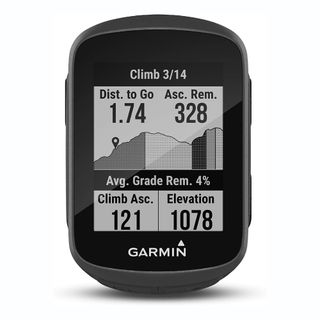
Best for those on a budget
The minimalist Garmin Edge 130 Plus does the basics well, and will be ideal for a lot of riders. Button controls and a sharp screen make it easy to use, and set-up is simple too.
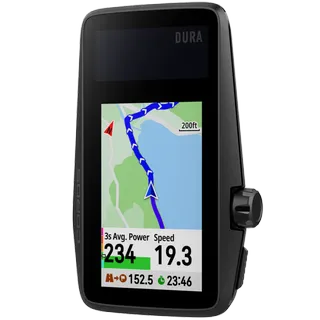 Best for battery life
Best for battery life
Best for battery life
With seemingly infinite battery life, the Coros Dura claims 120 hours charge, which can be replenished using solar energy at two hours for every one used. Coros has caused quite a stir with this one.
Our top picks: The best cycling computers
The best cycling computer
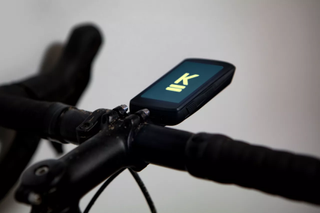
Hammerhead's Karoo 2 boasts a smartphone-like touchscreen that's easy to use
Specifications
Reasons to buy
Reasons to avoid
Now owned by SRAM, Hammerhead makes the Karoo 2, which works a bit differently from other cycling computers, with the ease of use and responsiveness of a smartphone that other cycling computers can't match.
That starts with an Android operating system rather than something proprietary and Hammerhead releases regular updates to its software, so it's likely to be futureproof. It's also more fully integrated with your smartphone.
The touchscreen is also much more smartphone-like. We found it super-responsive and you can pinch to zoom and, like a smartphone, navigate quickly between screens via shortcuts. The Karoo 2 is also quick to charge via its USB C port.
Read more: Hammerhead Karoo 2 full review
The best All-Round Cycle Computer
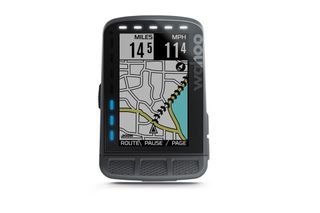
The Elemnt Roam is Wahoo's 'navigation first' cycling computer
Specifications
Reasons to buy
Reasons to avoid
The Wahoo Elemnt Roam brings what we know and love from the Elemnt Bolt into a slightly larger format. Function and compatibility-wise, the Roam covers all the basics as well as phone communication alerts, live tracking, and structured training, to name but a few.
It's the best rival for the more pricey Garmin Edge 830, but doesn't get a touchscreen, which is actually a benefit for some riders who ride in wet weather and find this feature far from ideal. The three main control buttons are well-sited at the bottom of the unit's face; they are large and were easier for us to use than the small side-mounted buttons of many cycling GPSs.
The battery isn't as long-lasting as some of the other computers' claimed times, but it's a handful of extra hours over the Bolt.
Read more: Wahoo Elemnt Roam full review
The best budget cycling computer
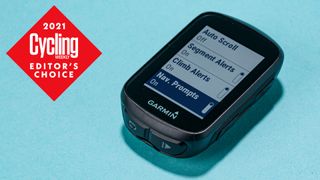
The Edge 130 Plus is stripped back and simple but still very capable
Specifications
Reasons to buy
Reasons to avoid
We know that this buyer's guide is looking very much like a 'Best Garmin Cycling Computer Guide', but it just goes to show the brand's domination in the field, with the Garmin Edge 130 Plus no exception, having gained a Cycling Weekly Editor's Choice Award.
The Edge 130 Plus is stripped back and simple, yet a very capable cycling computer. Using buttons instead of a touchscreen, we thought it was easy to set up and changing data fields is a breeze to do, even on the fly.
It can pair with ANT+ and Bluetooth accessories like heart rate monitors, cadence sensors and the best power meters. It is a device that would suit those who want to push their performance, chase Strava Live segments and train, but who don't need the top-end features offered at higher prices.
Read more: Garmin Edge 130 Plus full review
The best screen and features
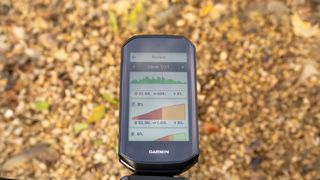
The vivid colour screen of the 1050, makes a good case for upgrading a 1040
Specifications
Reasons to buy
Reasons to avoid
The Edge 1050, Garmin’s flagship bike computer, boasts a spec so massive that few of us, myself included, are ever likely to use every feature in anger. Here’s a quick, whistlestop tour. It features turn-by-turn navigation with auto-rerouting that’s impressively accurate, even under tree cover, thanks to multi-band GNSS that uses GPS, GLONASS and Galileo. Training and performance functions include a power guide, stamina insights, cycling dynamics, grit and flow metrics, cycling dynamics, hydration alerts, heat and altitude acclimation, training status, suggested workouts, on-device course creation, road hazard alerts, group ride tracking… OK enough already.
The thing is, Garmin’s less pricey Edge 1040 and 840 computers all share the same features, plus better battery life to boot. So, where’s the value in the Edge 1050? As soon as I switched it on, it became blindingly obvious. The super-bright, high-resolution, 480 x 800-pixel screen offers up 88.9 mm (3.5″) of vivid, high-contrast, visual loveliness. It’s so colourful and crisp it makes Garmin’s other computer displays look washed out and fuzzy, even more so under bright sunshine and contrasty lighting conditions.
The Edge 1050 is also the first Garmin bike computer to feature Garmin Pay, which some riders will rate, but, as an existing Apple Pay user, I found it redundant. I was much more impressed with the built-in full-range speaker that generates proper tones and smooth, easily understandable voice commands. I won’t miss the 80s-style, 8-bit, chip-tune prompts that date the rest of Garmin’s range.
The speaker has enabled Garmin’s engineers to include another exclusive, yet quirky, feature that I found myself using all the time. A built-in bike bell that sounds just like the real thing. Tap the screen once to reveal a button, then hit that to emit a loud tone. Genius. Even better, if you have SRAM bonus buttons you can dedicate them to control it.
The Edge 1050’s battery life is less than the 1040 and 840, and substantially less than the 1040 Solar, but rated for 20 hrs of intensive usage, it still has enough juice to last two weeks of riding for most of us.
Is it worth the premium over the Edge 1040? If you’re choosing between the two, then definitely. If you’re looking to upgrade from the 1040, then the choice is less clear but, frankly, that screen is very seductive.
The best value
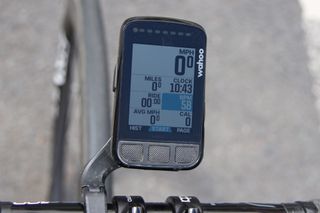
Wahoo's Elemnt Bolt V2 expands on the original now featuring a color screen
Specifications
Reasons to buy
Reasons to avoid
We are big fans of Wahoo's cycle computers for their ease of setup and bombproof software.
The Wahoo Elemnt Bolt has received an upgrade with more memory and a color screen. It's still button-operated rather than its 2.2" screen being touch-sensitive, but the buttons are now convex for easier operation, particularly when wearing gloves.
Set-up, pairing to a smartphone and configuration remain super-easy though and data is clear and legible. The LED array can help guide you too, although we didn't find it very useful.
Mapping and route management have been upgraded as well and there's clear turn-by-turn navigation and plenty of onboard map coverage without needing to download more basemaps. Navigation can be hit-and-miss though in our experience.
Other features include structured workouts, Strava Live integration and multisport handovers, as well as the newly-added Summit Climbs that give you a gradient profile for a pre-mapped route. Battery life is around 15 hours and there's quick USB-C charging.
Read more: Wahoo Elemnt Bolt V2 full review
Best for Battery Life
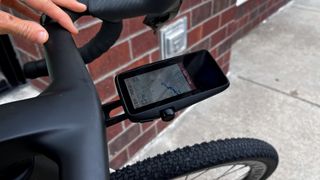
Boasting 120 hours on a single charge without the Solar topup, will you ever need to charge it?
Coros Dura Solar GPS
Specifications
Reasons to buy
Reasons to avoid
I received my test unit only a short time before the launch, which gave me limited time with the Coros. Initial impressions are the unit is small, super light and thin. Up against a Garmin Edge 1040 and Hammerhead Karoo, considering the claimed battery life it's a similar size to both, which is impressive.
The 'crown' similar to a watch winder (Which is what Coros is known for) might be a welcome sight for those needing to ride with thick gloves in winter, allowing you to navigate settings and pages.
I did experience a few hiccups in the first few rides, largely due to many features not being available until public launch time. I am told by Coros that a lot of these have updates coming or already fixed. This could be put down to a lack of familiarity with the new ecosystem. Unlike Garmin and Wahoo, a lot of the Dura's settings need to be set within the app rather than on the device itself.
Let us get to that battery life. After a week's riding including a big eight-hour-long backcountry ride, I still had 70% battery left. When I first spotted the Coros at Unbound, Haley Smith said "I have yet to charge the unit since receiving it at the Sea Otter Classic – 90 hours of riding time and counting". Time will tell truly how long the battery will last but initial impressions look good.
Read more: Coros Dura First Impressions
Best Value Garmin
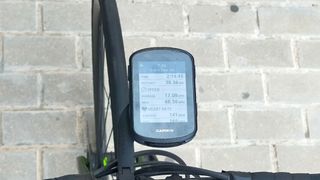
It is hard to see why you would need anything better than the Edge 540
Specifications
Reasons to buy
Reasons to avoid
Garmin really stepped up the performance with the 540, while keeping key features which its predecessor the Edge 530 had become so well known for.
The 540 is now truly the entry into Garmin's range of training and performance-based computers. This is despite Garmin offering the more affordable and brilliant Edge 130 Plus. With the addition of the Climbpro, course demands, multi-band GNSS and power guide features, you could say Garmin needn't have gone further than that. It is the inclusion of Garmin Coach, found on the Edge 840 and 1050 that really takes the 540 to the next level.
Mapping also saw big upgrades with features like popular roads and trails and a much bigger catalogue of POIs. Living in Spain, especially in the Summer you are acutely aware of your water supplies, so the addition of simple things like water fountains could be a literal lifesaver.
Whilst I would prefer a touchscreen and as I mentioned riding in Spain means I am less often using gloves, like those in the UK or cooler parts of the US. I can see that the button operation could be a big draw for a lot of people. Considering the Edge 540 is now available in a Solar version, it is hard to see why you would choose the Edge 840 over this.
Read more: Garmin Edge 540 full review
The best value cycling computer for navigation
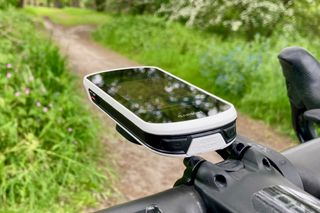
Garmin Edge Explore 2
Our expert review:
Specifications
Reasons to buy
Reasons to avoid
The Edge Explore 2 is a kind of antidote to the all-singing, all-dancing, solar-powered Edge 1040 Solar. It costs less than half as much as the 1040 and it’s aimed at the rider who doesn’t need all the performance metrics or the outdoor structured workouts. There’s also no Strava Live Segments. That said, it will pair with Bluetooth and ANT+ sensors, sync everything with Garmin Connect (via Bluetooth; it doesn’t have WiFi), upload to Strava and other training apps and give you smart notifications, group ride messaging and incident detection - always handy.
If you've been using a heart rate monitor and power meter you'll get 'Highlights' after finishing your ride - a new V02max (if applicable) and recovery time - which feeds into Garmin Connect once synced and adds to your overall fitness data if you're tracking it.
So although navigation is the Edge Explore 2's primary function - and it does it incredibly well - training is by no means neglected.
In testing we found the Edge Explore 2 easy to set up, easy to use, easy to afford (relatively speaking) and ideal for most cyclists most of the time. It doesn't have the largest range of options (only three activity profiles for example) or the latest version of ClimbPro, and it's a shame you don't get an out-front mount in the box, but overall it's a great unit for the money.
Read more: Garmin Edge Explore 2 full review
The best cycling computer for training
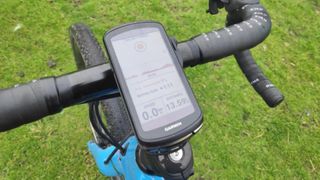
Specifications
Reasons to buy
Reasons to avoid
The ability to charge the Edge 1040 Solar via the sun is quite the attention grabber. Garmin says the Power Glass™ solar charging extends battery life up to 42 minutes per hour in battery saver mode, giving you up to 45 hours of battery life in what it describes as "demanding use cases" and up to 100 hours in battery saver mode.
It's worth noting that this is based on an assumption of continuous 75,000 lux conditions during daytime rides. Essentially that means consistently bright sunshine that you may well enjoy during summer rides but, depending on where you live, are less likely to experience during the cooler seasons. Naturally, your expectations should match the amount of cloud cover.
The Garmin Edge 1040 Solar also features a revamped user interface that we found to be far easier to navigate than other Garmin models. The home page features customizable data fields so you can easily scroll through your recent activity history, training schedule, weather forecast and more. You can also view data such as your recovery time using the 'glances' feature.
Other interesting features include the Power Guide, which generates a pacing strategy for your chosen route to help you best manage your efforts. Naturally, all this tech doesn't come cheap, but if you're after an all-singing, all-dancing cycling computer you're unlikely to be disappointed.
Read more: Garmin Edge 1040 Solar first ride
Good features at a reasonable price
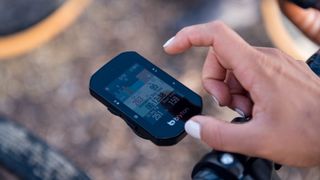
Bryton's Rider 420 E delivers an impressive price-to-performance ratio
Specifications
Reasons to buy
Reasons to avoid
The Bryton Rider 420 is one of the brand's more budget-friendly options. The fully-featured head unit supports every sensor under the sun and provides advanced data metrics like normalized power and TSS.
While it doesn't have a color screen, it can offer turn-by-turn directions, though without a basemap you are just following a black line on a blank screen. Setup can be done on the device itself, or through the companion app, which wasn't a totally intuitive experience for us, but it still works pretty well. Best of all, with a 35-hour battery life, it will outlast most other computers on the market.
With around 77 available data fields, it's comparable to the Garmin Edge 130 or the Wahoo Elemnt Bolt, but it isn't exactly a fair fight as for the price saving you do lose maps and user-friendliness, but if you're on a tight budget, it's a fair price for a functional unit.
Read more: Bryton Rider 420 full review
Best cycling computer for simplicity
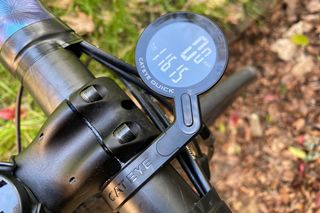
Cateye's Quick Wireless computer is straightforward to use and easy on the eye
Specifications
Reasons to buy
Reasons to avoid
Tested alongside a Garmin Edge 530 , the Cateye Quick mirrored the more powerful unit digit for digit in terms of speed and distance accuracy. Not bad for such a simple and relatively, in the scheme of things, cheap unit.
It’s also easy to read at speed and the out-front position puts it neatly in the field of view. As with all of Cateye’s simple computers, the battery life is measured in years rather than hours.
With the delightful simplicity, you do limit functionality. There isn't any compatibility beyond the wireless speed transmitter and you won't get a record of where you've been as there's no GPS chip on board. But if you are looking for a neat and simple cycling computer and don't need connected features, the Cateye Quick is accurate, reliable, and best of all looks really cool.
Read more: Cateye Quick full review
How we test
Cycling Weekly has a team of testers with vast experience in testing bikes, components, clothing and accessories across a wide range of prices and spec levels, so they know bikes and tech inside out and have the experience to know what makes a great cycling product.
Our experience means that you'll have a consistent, in-depth viewpoint, which is reflected in our product scoring. You can find out more on our How We Test page.
When it comes to testing the best cycling computers we log plenty of miles both outdoors and on the turbo to assess their performance. We take into consideration a range of factors, including how easy they are to set up and use and the variety of functions they offer, both as navigational and training tools, as well as practical considerations like battery life, charge time, resistance to weather and of course value for money.
FAQs about the best cycling computers
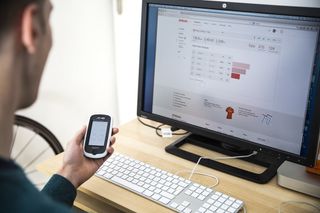
What features can I expect from an entry level non-GPS cycling computer?
The most basic cycle computers are generally available for about the cost of a takeout lunch, (or even cheaper if you do a bit of shopping around). Of course, for this sort of money your computer isn't going to be packed full of functionality.
The very cheapest bike computers will measure the basics such as your speed and cadence (and from these calculate things like your average speed and average cadence), taking these figures from speed and cadence sensors located on the bike frame, to which they are connected using wires.
Pay a little bit more, and you can upgrade to a wireless cycling computer, which will connect to your speed and cadence sensors without the need for having unsightly wires running all over your frame. These sorts of computers are probably the best option if you're on a budget and aren't worried about uploading your rides to Strava or doing any serious, structured training.
In general, just less than a triple-figure price tag will give you even more choice cycling computer-wise, and they will begin to offer more functionality, although in general, unless you get one of a deal, it's unlikely that these models will go quite as far as being a true GPS enabled unit.
What features can I expect from entry level GPS cycling computers?
An entry-level GPS unit will be great for getting you going with tracking your rides, and possibly other features. You can often find bundle deals with a heart rate monitor and/or cadence sensor, which might push the price up slightly, but work out more cost-effective than buying items separately.
At this price point, manufacturers prioritize ease of use, small size and low weight – usually well below 3.5oz/ 100g.
The GPS unit will typically track your ride statistics such as distance, time, speed and lap times but will not provide navigation. Most units will pause automatically when you stop moving and resume when you restart and provide ANT+ connectivity for external sensors.
Ride data is typically displayed in two or three rows on a black and white screen. There may be the option to specify which data items and how many rows are displayed, but one of the selling points of these devices is that you turn them on and start cycling without needing to delve into complex configuration options, so personalization tends not to be a priority.
The GPS may also allow you to set alerts when you have reached a target value such as having ridden for a pre-specified time. You can get virtual competitor functions so that you can see how well you are doing compared to previous rides of the same route.
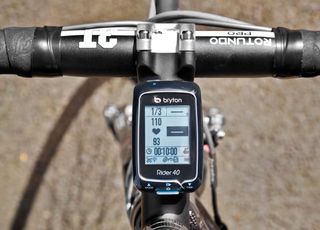
The Bryton Rider 40 is a mid-range unit emphasising training plans
What features will I find on a mid-range GPS cycling computer?
Spend a bit more and you will start to get additional functionality in your GPS. Mid-level units can often come bundled in with a heart rate monitor or cadence sensor, but will also have a high level of compatibility, so will be capable of displaying and tracking data from existing hardware you have, including any power data.
A mid-range unit will usually be larger with a bigger screen which can display more data, often in color. Data storage capacity will probably also increase. The unit may be controlled by buttons or a touchscreen, and many mid-range units add mapping and navigation functionality. Some will have basemaps preinstalled, or that can be downloaded while others may only support breadcrumb trails.
Because of how GPS satellite triangulation works, altitude data calculated from GPS is less accurate than positional data. Thus higher-spec units will often add a barometric altimeter to increase recording accuracy for height and rate of ascent.
Many mid-range units now include Bluetooth synchronization to a smartphone, meaning your computer will show you calls and texts on screen, and other data from the phone, such as weather alerts. Some computers send data back to the phone, so it can transmit ride progress data to the internet, where people you allow can view it, and let you upload your rides without the need for a USB cable.
What features can I expect to find on a high-end GPS bike computer?
The arms race in high-end cycle computers continues and manufacturers seem to be announcing new top-of-the-range features every few months. These products come in at almost half the price of a decent road bike or more, weigh up to 7oz/ 200g and may come packaged with a heart rate monitor strap and a cadence sensor.
At this price point, you should expect a color touchscreen, mapping, turn-by-turn navigation, and advanced training features and integration. This may include WiFi connectivity for data transfer, route suggestions, and the ability to share a route with your ride companions.
These higher-end computers are likely to have integration with other devices and applications. Most will connect to electronic drivetrains for gear information, show Strava Live Segments and allow for workouts to be synced directly from third-party apps like TrainingPeaks or Today's Plan.
There was a time when battery life was an issue on these computers with their large screens, but now you can expect about 20-hours of run time. These higher-end units will all have access to multiple positional satellite constellations like the Russian GLONASS, Chinese BeiDou, and the EU's Galileo network.
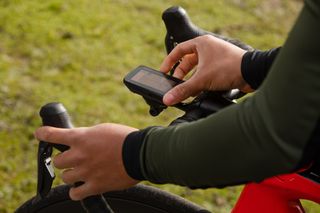
The more expensive GPS computers will offer turn-by-turn navigation and a host of other features.
How can I use a bike computer to analyze my ride data?
Even basic cycling GPS units allow you to download data post-ride to the manufacturer’s ride recording site and phone app. These apps support ride analysis, training plans and social interaction, although the quality of the functionality and user interface varies. But you can then upload your data to Strava, Training Peaks or other third-party sites if the manufacturer's site falls short.
Analysis options will be richer, of course, if you have used peripheral devices such as a cadence sensor or power meter to capture extra data.
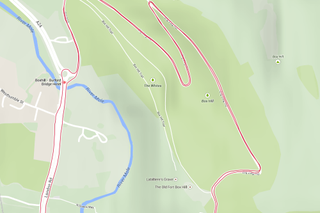
Manufacturers' ride analysis apps provide mapping and ride statistics
What are the best alternatives to a cycling computer?
If you don’t want to buy a cycling-specific GPS, other options are available. Modern smartphones will have a GPS chip built into them. This may not be as precise as the chip in a dedicated cycling GPS but should still allow you to track your position with reasonable accuracy. You can log your rides using a smartphone app like Strava, with the best smartphone apps offering much of the functionality of a basic computer.
You can either put your phone in a pocket or buy a phone mount that attaches to your bars or stem, like a Quadlock or Rokform phone mount. Both are good examples of how to mount your phone on the handlebars safely.
If you use your phone beware of water, as many are not water-resistant. Battery life may be an issue too, especially if you want to use your phone’s display to see your data while you ride.
If you are going to carry your phone, another option is to use its GPS capability to collect ride data, which is transmitted via Bluetooth to a bar-mounted display unit, like the Cateye Padrone.
This allows you to keep your phone out of the way and turn off the screen whilst still being able to see ride statistics. Display units will usually also show data collected from peripheral devices via ANT or Bluetooth.
GPS-enabled sports watches are also popular among triathletes and mountain bikers. Our page on the best smartwatches for cycling gives you the full lowdown on wearable fitness trackers that are great when riding.
These allow you to track activity across different sports and many allow connection to peripheral devices and include navigation too. Some come with a bar mount so that you can use the watch attached to the bike or on your wrist.
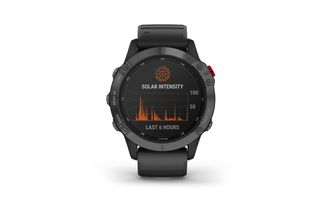
Garmin Fenix 6 is a GPS-enabled smartwatch
Get The Leadout Newsletter
The latest race content, interviews, features, reviews and expert buying guides, direct to your inbox!
Hannah is Cycling Weekly’s longest-serving tech writer, having started with the magazine back in 2011. She has covered all things technical for both print and digital over multiple seasons representing CW at spring Classics, and Grand Tours and all races in between.
Hannah was a successful road and track racer herself, competing in UCI races all over Europe as well as in China, Pakistan and New Zealand.
For fun, she's ridden LEJOG unaided, a lap of Majorca in a day, won a 24-hour mountain bike race and tackled famous mountain passes in the French Alps, Pyrenees, Dolomites and Himalayas.
She lives just outside the Peak District National Park near Manchester UK with her partner, daughter and a small but beautifully formed bike collection.
- Matt Ischt-BarnardEcomm and Tech Writer
-
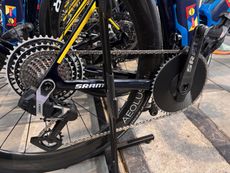 Lidl-Trek debuts SRAM Red XPLR gravel groupset for Omloop Het Nieuwsblad
Lidl-Trek debuts SRAM Red XPLR gravel groupset for Omloop Het NieuwsbladWorldTour team riders to use the new 13-speed gravel groupset
By James Shrubsall Published
-
 Does cycling make you better in bed?: All you need to know about sex, fertility and saddles
Does cycling make you better in bed?: All you need to know about sex, fertility and saddlesDebunking cycling's sexual health myths
By Chris Marshall-Bell Published